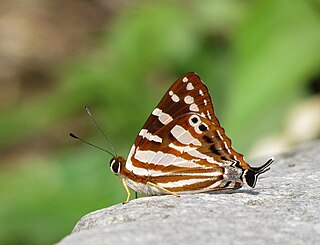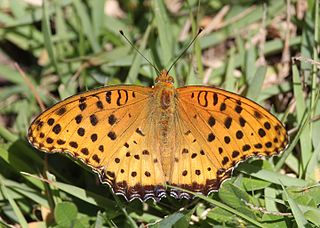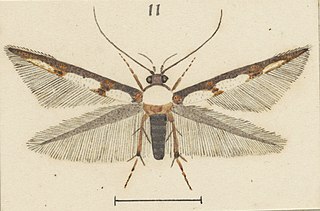
Dodona dipoea, the lesser Punch, is a small but striking butterfly found in the Indomalayan realm that belongs to the Punches and Judies, that is, the family Riodinidae.

Dodona egeon, the orange Punch, is a small but striking butterfly found in the Indomalayan realm - in Mussoorie to Assam, Burma (nominate) and Peninsular Malaya that belongs to the family Riodinidae.

Ixias pyrene, the yellow orange tip, is a small butterfly of the family Pieridae, that is, the yellows and whites, which is found in Sri Lanka, India and southeast Asia.

The Indian fritillary is a species of butterfly of the nymphalid or brush-footed family. It is usually found from south and southeast Asia to Australia.
Copticostola is a genus of moths in the family Gelechiidae. It contains the species Copticostola acuminata, which is found in Tabasco, Mexico.
Glyphipterix archimedica is a moth in the family Glyphipterigidae. It is known from Zimbabwe.

Polyhymno cleodorella is a moth of the family Gelechiidae. It is found in Gambia.
Helcystogramma juventellus is a moth in the family Gelechiidae. It was described by Thomas de Grey, 6th Baron Walsingham, in 1897. It is found in Jamaica and Mexico (Tabasco).
Charistica walkeri is a moth in the family Gelechiidae. It was described by Walsingham in 1911. It is found from Panama to Colombia.
Tricyanaula aurantiaca is a moth of the family Gelechiidae. It was described by Walsingham in 1887. It is found in Sri Lanka.
Aristotelia penicillata is a moth of the family Gelechiidae. It was described by Walsingham in 1897. It is found in West Indies, where it has been recorded from Haiti.

Thiotricha tenuis is a moth of the family Gelechiidae. It was described by Walsingham in 1891. It is found on the Seychelles, Mauritius, Réunion, South Africa and Gambia.
Polyhymno colleta is a moth of the family Gelechiidae. It was described by Walsingham in 1911. It is found in Mexico (Guerrero).
Polyhymno leucocras is a moth of the family Gelechiidae. It was described by Walsingham in 1911. It is found in Mexico (Sonora).
Thiotricha sciurella is a moth of the family Gelechiidae. It was described by Thomas de Grey in 1897. It is found on the West Indies and from Mexico to Brazil.
Antaeotricha walchiana is a moth of the family Depressariidae. It is found in Venezuela, Panama, Trinidad, Colombia, French Guiana, Brazil, Bolivia and Peru.
Timyra toxastis is a moth in the family Lecithoceridae. It was described by Edward Meyrick in 1908. It is found in southern India.
Psittacastis molybdaspis is a moth in the family Depressariidae. It was described by Edward Meyrick in 1926. It is found in Peru.
Moca radiata is a moth in the family Immidae. It was described by Thomas de Grey in 1897. It is found in the Democratic Republic of the Congo and Gabon.

Stathmopoda aristodoxa is a species of moth in the family Stathmopodidae. It is endemic to New Zealand. It is classified as "At Risk, Naturally Uncommon" by the Department of Conservation.






